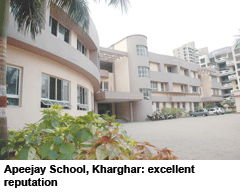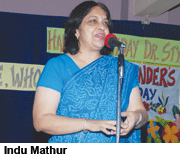Since it admitted its first batch of 29 students in 2000, this CBSE-affiliated school is ranked among the top schools of Navi Mumbai, the fast-developing satellite city of Mumbai
 Promoted in Kharghar — a distant suburb of Mumbai — in the foothills of the Pandavkada Hills in the millennium year (2000) by the Delhi-based Apeejay Education Society (estb.1967), the CBSE-affiliated Apeejay School, Kharghar has built itself an excellent reputation over the past 11 years since it admitted its first batch of 29 students. Since then, the number of students in this co-ed K-12 school has increased to 1,824 including 860 girl children, with this school and the eponymous Apeejay School, Nerul enjoying the reputation of being ranked among the top schools in Navi Mumbai, the fast-developing satellite city of Mumbai.
Promoted in Kharghar — a distant suburb of Mumbai — in the foothills of the Pandavkada Hills in the millennium year (2000) by the Delhi-based Apeejay Education Society (estb.1967), the CBSE-affiliated Apeejay School, Kharghar has built itself an excellent reputation over the past 11 years since it admitted its first batch of 29 students. Since then, the number of students in this co-ed K-12 school has increased to 1,824 including 860 girl children, with this school and the eponymous Apeejay School, Nerul enjoying the reputation of being ranked among the top schools in Navi Mumbai, the fast-developing satellite city of Mumbai.
“In Apeejay Kharghar, we earnestly believe that education is not prep-aration for life, but life itself, in the words of the late US President John F. Kennedy. Therefore we ensure a life-enriching experience for our students by facilitating them with the best faculty, infrastructure, opportunities and environment. We believe the aim of education is to teach values not facts, and we make sure the right values and ideals are imparted to every child of our family, so they grow up to become fine human beings, less driven by materialistic pursuits. Academic excellence accompanied by extra-curricular brilliance makes each pupil stand out among his peers,” says Indu Mathur, principal of the school. An organic chemistry postgraduate of Pune University, who began her academic career as a lecturer at the National Defence Academy, Khadakwasala, and later served as principal of Army Public School, Lucknow (2001-2009), Mathur signed up as principal of Apeejay, Kharghar in June 2009.
According to Mathur, the school’s faculty is in step with and wholly committed to the new concept of Continuous and Comprehensive Eva-luation (CCE) mandated by CBSE (Central Board of Secondary Education) with effect from October 2009. “The intent behind introduction of CCE is to enhance students’ formative skills, while discarding the old pedagogy of learning by rote,” she says. “Therefore we pay considerable attention to co-curricular and extra-curricular activities such as elocution, art, drama, creative writing and sports. I want to make learning and teaching both joyous and creative for our students and teachers.”
 The school’s emphasis on CCE and new pedagogies has transformed in-service teacher training into a high priority objective, says Mathur. “A successful team is a group of many hands but one mind. Therefore our philosophy is to continuously train our teachers to discharge the role of catalysts who enhance the teaching-learning process rather than follow the old teacher-centric style of instruction. Consequently our teachers are trained to blend new ICT (information communication technologies) with teaching, and use multimedia and audiovisual equipment to make the learning process interesting and enjoyable,” explains Mathur.
The school’s emphasis on CCE and new pedagogies has transformed in-service teacher training into a high priority objective, says Mathur. “A successful team is a group of many hands but one mind. Therefore our philosophy is to continuously train our teachers to discharge the role of catalysts who enhance the teaching-learning process rather than follow the old teacher-centric style of instruction. Consequently our teachers are trained to blend new ICT (information communication technologies) with teaching, and use multimedia and audiovisual equipment to make the learning process interesting and enjoyable,” explains Mathur.
Evidently these classroom innovations are delivering results. The school’s class X exam results last year placed it among the top five schools in Maharashtra, according to the Hindustan Times and two of its teachers — Judith John (English) and Kusum Prajapati (geography) — were conferred CIDCO’s 2010-11 best teacher awards in the senior secondary and higher secondary categories respectively.
Apeejay, Kharghar is a constituent school of the Delhi-based Apeejay Education Society (AES), which has promoted 29 educational institutions across the country including 13 K-12 schools and 16 higher education institutions with an aggregate enrolment of 32,000 students and 2,200 teachers. Promoted by the late Dr. Stya Paul (1919-2010), AES is currently chaired by his daughter Sushma Berlia.
Given its august parentage, the Apeejay School, Kharghar has a reputation to maintain. Therefore the AES trustees/management have generously endowed the school with excellent infrastructure. Sited on a three-acre campus, the school building is a ground-plus-two-storeys structure, with 61 classrooms and four laboratories (for physics, chemistry, biology and an integrated science lab for class VI-XII students). The school is also equipped with computer labs comprising 50 PCs, two multi-purpose halls which seat 500 and 800 students respectively, and a library with 10,000 volumes and 25 journal subscriptions.
Sports facilities include play-grounds for football, hand-ball, basketball, volleyball, and indoor sports such as table tennis, badminton, chess, gymnastics, carom, skating and karate.
To maintain its high standards, Mathur is committed to the orderly growth and development of Apeejay, Kharghar which has just completed its first decade of operations. Future plans include introduction of a commerce stream in the higher secondary school which will inflate aggregate capacity to 1,855 students, construction of a new building equipped with separate physics, chemistry and biology labs, and a new library.
“The institutional objective of Apeejay School, Kharghar is to be unanimously acknowledged as the best K-12 day school in Navi Mumbai for providing excellent academic and extra-curricular education. We aspire to live up to our motto: ‘Soaring High is my Nature’,” says Mathur.
|
Admission & fees
Students are admitted into nursery on the basis of an informal interaction with parents. However, there is an entrance test from class 1 onwards.
Admission fee: Nursery — Rs.17,600; KG-class XII — Rs.15,400
Tuition fees (quarterly). Nursery: Rs.7,215; class I-IV: Rs.5,676; class V-VIII: Rs.5,511; class IX-X: Rs.6,105; class XI-XII (with computers): Rs.9,360.
For further details contact Apeejay School, Sector 21, Kharghar, Navi Mumbai, Mumbai 410210. Telephone: 022 27745501/27746295, email: skool.khg.by@ apj.edu; website: www.apeejay.edu/kharghar
|
Manas Shrivastava (Mumbai)